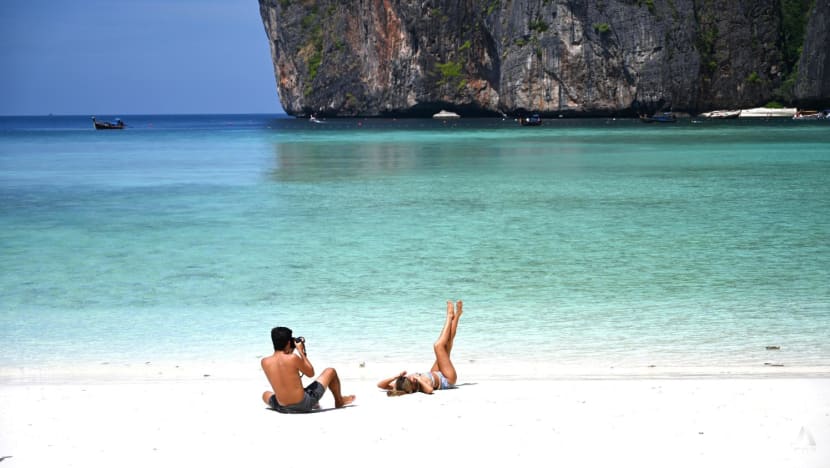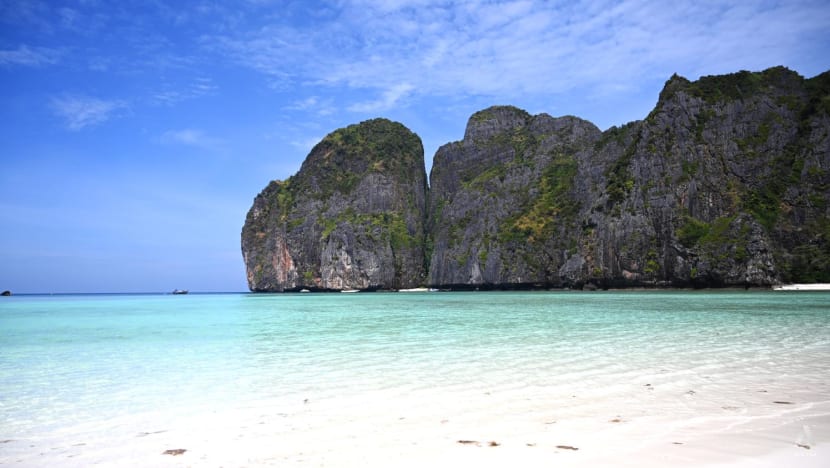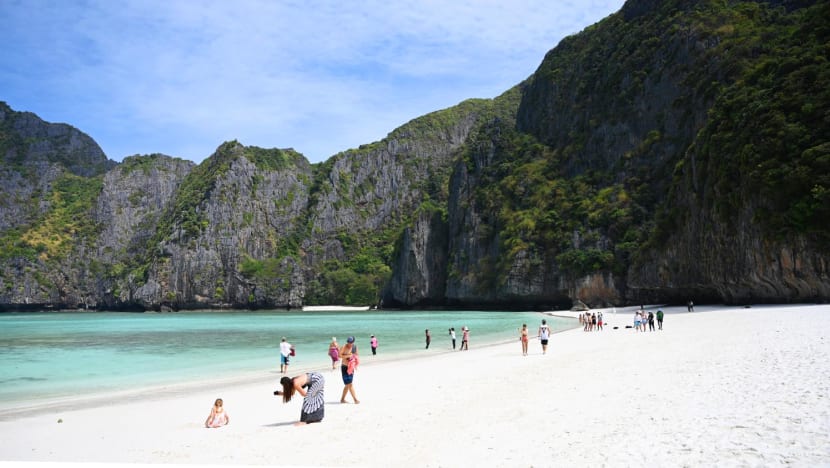‘The sea has truly changed’: Thailand’s Maya Bay reopens to visitors after nature allowed to heal itself

Maya Bay in Krabi, southern Thailand. (Photo: CNA/Pichayada Promchertchoo)
PHI PHI LEH, Thailand: Oranee Kittitorraneerut remembered feeling elated when her eyes swept the panoramic view of Maya Bay for the first time in more than three years.
Sheltered by towering limestone cliffs, the iconic crystal clear blue lagoon was serene and magnificent with no tourist boat in sight.
Its crescent-shaped beach was pure white and free from rubbish. The sand was warm and powdery beneath her bare feet.
“The moment I stepped on the beach at Maya Bay, it felt so relaxing. The sand was so white and so fine. The view of limestone cliffs on my left and right, embracing the lagoon of crystal clear water, was so pleasing to the eye,” said Oranee.
The 24-year-old tour guide from Krabi had never seen Maya Bay like this before.
“It’s a popular tourist attraction. There used to be a huge number of visitors on the beach every day, and boats too,” she added.
Years of mass tourism had a devastating impact on the ecosystem around the bay. In June 2018, the Thai government announced that the area will be closed to tourists, in order to allow nature to heal itself.
The area remained closed for more than three years before its reopening on Jan 1 this year. This followed a significant recovery of its ecosystem and came at a time when Thailand’s tourism sector badly suffered from the COVID-19 pandemic.

These days, tourism at Maya Bay is not the same as before. New rules were introduced by authorities to ensure the area remains protected.
Advance booking is now required prior to the visit and only 375 people are allowed at one time between 7am and 6pm daily.
Tourists can spend up to one hour at the bay but swimming is no longer permitted.
Moreover, boats carrying passengers to the site must dock at a designated spot behind the bay, where a long wooden walkway leads visitors to the world-famous beach.
“Some tourists may be a bit sad that they can’t swim but I’d tell them that even though swimming is prohibited, they can really enjoy the beauty of this place and take photos without people swimming in the background,” Oranee said.
“This way, they also support the conservation of sharks and corals in this area. So, they’re okay and happy.”
SHARKS, CORALS AND A NEW TOURISM MODEL AT MAYA BAY
Maya Bay is the crown jewel of Phi Phi Islands in southern Thailand. It is situated in the Hat Noppharat Thara – Mu Ko Phi Phi National Park in Krabi.
The location was chosen to portray a fictional paradise beach hidden from the rest of the world in Danny Boyle’s 2000 movie The Beach, starring Leonardo DiCaprio.
Its stunning beauty shot to global fame and boosted mass tourism that brought some 5,000 visitors to the bay each day, along with hundreds of boats.

Following its closure, Maya has become a pristine cove, where more than 30,000 colonies of corals are growing undisturbed.
Its once crowded lagoon has turned into a safe haven for marine life. Underneath its calm glass-like water is a new nursery ground for blacktip reef sharks.
At least 160 of them were captured in a drone flight last December, according to Thon Thamrongnawasawat – a marine scientist from Kasetsart University who is very involved in the rehabilitation of Maya Bay.
Despite the return of tourist activities, he told CNA the impact on marine environment is almost nonexistent.
“Before Maya was closed for rehabilitation, boats were the main problem. So many of them had entered the bay. They were the main cause of sediments and disturbed corals and sharks,” said the scientist.
Although 4,125 visitors are allowed in Maya Bay each day, their presence is unlikely to disturb the blacktip reef sharks or the corals, which are located hundreds of metres away from the beach, according to him.
“So, if you ask me about the sea, I can firmly say that it’ll continue to recover. The reopening of Maya Bay and the rehabilitation of its marine environment is almost non-related because tourists stay on land and don’t bring boats into the bay or swim,” he explained.
The closure and rehabilitation of Maya Bay is part of an ecological restoration programme known as Phi Phi Model. It was initiated by Thon in 2016 to ensure conservation and sustainable tourism at Phi Phi Islands, which used to welcome nearly 2 million tourists per year before the pandemic.
“Part of Phi Phi Model is to raise awareness,” he said.
“Of course, the most important people are those who bring tourists to Maya Bay. As long as they feel like protecting it, love it and explain the rules for tourists to follow, it’ll be fine."
Maya Bay is the main attraction of Phi Phi Islands. Its reopening was welcomed by tour operators, whose business heavily relies on boat trips to different islands and bays.
Since January, tour company Sea Eagle has noticed an increase in bookings from tourists in Krabi.
Its general manager Naphak Pannawitchayakun told CNA the COVID-19 pandemic had forced the company to close for several months because there were hardly any tourists.
“The reopening of Maya Bay after many years of closure is exciting. It’s clear that it has attracted tourists and made more people book our tours,” she said.
For her, tourism should go hand in hand with conservation because without nature, there will be no income.
“Tourism operators might have focused on their business in the past and just wanted to bring in tourists. Now, they are increasingly coming to the realisation that when the sea is calm, a lot of marine animals appear,” said president of the Krabi Tourism Association, Sasithorn Kittidhrakul.
“It’s clear the sea has truly changed after the closure,” she added.

According to Sasithorn, Krabi is set to continue promoting tourism but will focus more on “the quality of tourists than their quantity”. The province will also work to reduce the congestion at tourist attractions and inform visitors of new requirements.
“We want visitors who are aware of the importance of conservation,” she said.
Away in the sea, Oranee led a group of tourists to a snorkelling spot in Phi Phi Islands after a visit to Maya Bay.
Sitting on the deck of the speedboat, Pitchakorn Chen, a tourist from Bangkok, recalled his time at the world-famous lagoon.
“We managed to visit it. If we can preserve it, our children and grandchildren may be able to visit it in the future too. But if we lose it, it could forever be lost,” he said.















